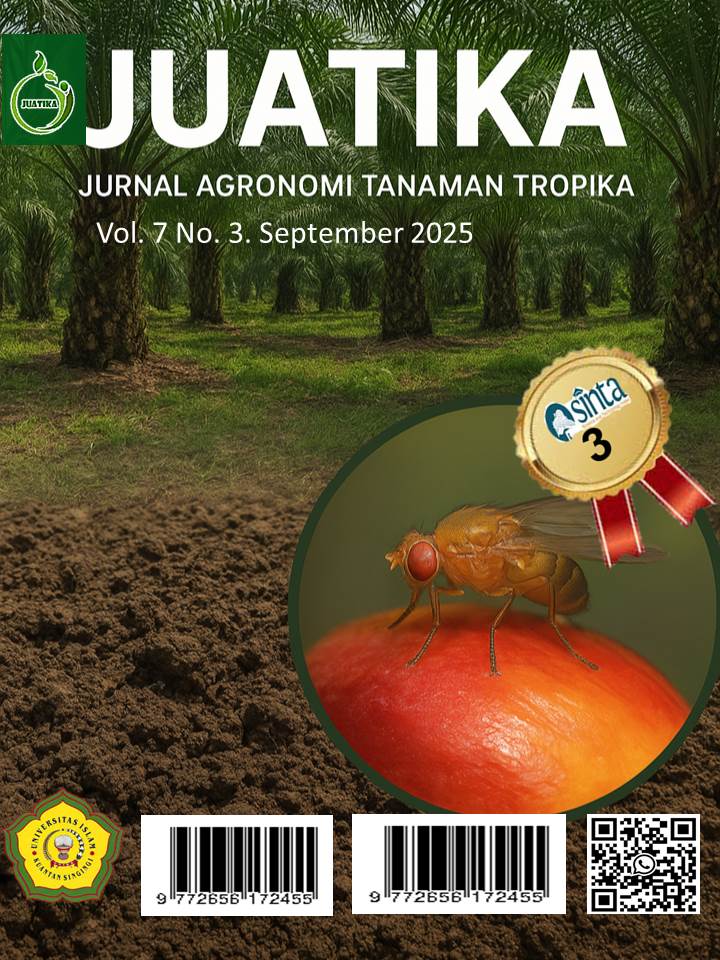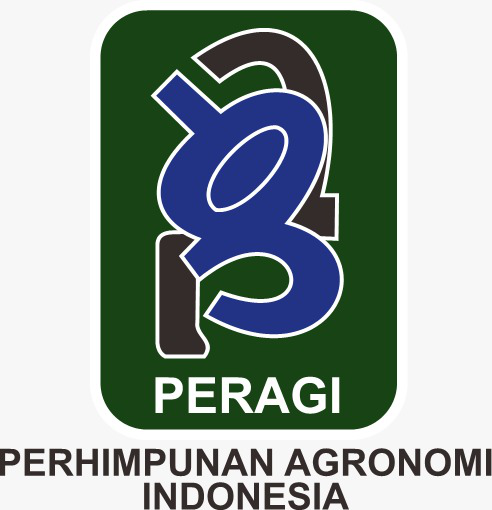Ecological Study of Citrus Plants (Citrus SPP.) in The Gunung Leuser National Park Area Southeast Aceh
Abstract
Citrus is one of the strategic horticultural commodities with high economic and genetic value, yet its ecological basis in natural habitats remains understudied, particularly in conservation areas. This study aimed to assess the ecological conditions of wild-growing citrus plants (Citrus spp.) in the Gunung Leuser National Park (TNGL). A descriptive exploratory method was employed, combining field surveys with direct observations and quantitative measurements of environmental variables, including air and soil temperature, humidity, light intensity, rainfall, and elevation. The results indicate that citrus plants can grow at air temperatures of 18–31.6 °C, soil temperatures of 22–23 °C, air humidity of 79.4–80.3%, light intensity of 27.6–2871 lux, annual rainfall of 2,500–4,000 mm, and altitudes of 350–400 m above sea level. These conditions reflect a humid tropical ecosystem favorable for wild citrus growth. The findings demonstrate the citrus plant’s adaptability to shaded, moist environments, and its potential as a source of valuable local germplasm. This study provides a scientific basis for the conservation, management, and further development of adaptive citrus varieties suited to tropical forest conditions.
Downloads
References
Assauwab, M. H., Sumoharjo, D., & Sadri, S. (2025). Exploration of Citrus germplasm in Mount Leuser National Park region. Jurnal Agronomi Tanaman Tropika (Juatika), 7(1). https://doi.org/10.36378/juatika.v7i1.3960
Bueno, A. C. R., Prudente, D. A., Machado, E. C., & Ribeiro, R. V. (2012). Daily temperature amplitude affects the vegetative growth and carbon metabolism of orange trees in a rootstock-dependent manner. Journal of Plant Growth Regulation, 31(3), 309–319. https://doi.org/10.1007/s00344-011-9240-x
Curk, F., Luro, F., Hussain, S., & Ollitrault, P. (2022). Citrus origins. In Citrus production. https://doi.org/10.1201/9781003119852-1
Islam, M. J., Kunzmann, A., Bögner, M., Meyer, A., Thiele, R., & Slater, M. J. (2020). Metabolic and molecular stress responses of European seabass, Dicentrarchus labrax, at low and high temperature extremes. Ecological Indicators, 112, 106118. https://doi.org/10.1016/j.ecolind.2020.106118
Jifon, J. L., & Syvertsen, J. P. (2003). Erratum: Moderate shade can increase net gas exchange and reduce photoinhibition in citrus leaves (Tree Physiology 22, 1079–1092). Tree Physiology, 23(10), 719.
Malik, S. K., Kumar, S., Singh, I. P., Dhariwal, O. P., & Chaudhury, R. (2013). Socio-economic importance, domestication trends and in situ conservation of wild Citrus species of Northeast India. Genetic Resources and Crop Evolution, 60(5), 1655–1671. https://doi.org/10.1007/s10722-012-9948-x
Nazari, A. A., & Karyadi, B. (2024). Morphological characterization and conservation of Nagami citrus (Citrus japonica) as an antioxidant and nutrient source. Jurnal Agronomi Tanaman Tropika (Juatika), 6(2). https://doi.org/10.36378/juatika.v6i2.3472
Nugraha, K. I., Suryanti, S., & Mawandha, H. G. (2024). Growth optimization of several varieties of vanilla plants (Vanilla planifolia Andrews) using various light intensities. Jurnal Agronomi Tanaman Tropika (Juatika), 6(2). https://doi.org/10.36378/juatika.v6i2.3572
Ribeiro, R. V., Machado, E. C., Espinoza-Núñez, E., Ramos, R. A., & Machado, D. F. S. P. (2012). Moderate warm temperature improves shoot growth, affects carbohydrate status and stimulates photosynthesis of sweet orange plants. Brazilian Journal of Plant Physiology, 24(1), 37–46. https://doi.org/10.1590/S1677-04202012000100006
Ribeiro, R. V., & Machado, E. C. (2007). Some aspects of citrus ecophysiology in subtropical climates: Re-visiting photosynthesis under natural conditions. Brazilian Journal of Plant Physiology, 19(4), 393–411. https://doi.org/10.1590/S1677-04202007000400009
Roose, M. L., Gmitter, F. G., Lee, R. F., & Hummer, K. E. (2015). Conservation of citrus germplasm: An international survey. Acta Horticulturae, 1101, 33–38. https://doi.org/10.17660/ActaHortic.2015.1101.6
Santos, P. M., Thornton, B., & Corsi, M. (2012). Adaptation of the C4 grass Panicum maximum to defoliation is related to plasticity of N uptake, mobilisation and allocation patterns. Scientia Agricola, 69(5), 293–299. https://doi.org/10.1590/S0103-90162012000500002
Susanti, R., Pratama, B. A., Rahmawati, K., & Suzuki, E. (2021). Preliminary study on plant ecology in Tangkahan area, Gunung Leuser National Park. IOP Conference Series: Earth and Environmental Science, 762(1). https://doi.org/10.1088/1755-1315/762/1/012020
Susilowati, A., Elfiati, D., Rachmat, H. H., Yulita, K. S., Hadi, A. N., Kusuma, Y. S., & Batu, S. A. L. (2020). Vegetation structure and floristic composition of tree species in the habitat of Scaphium macropodum in Gunung Leuser National Park, Sumatra, Indonesia. Biodiversitas, 21(7), 3025–3033. https://doi.org/10.13057/biodiv/d210720
Vincent, C., Morillon, R., Arbona, V., & Gómez-Cadenas, A. (2020). Citrus in changing environments. In The genus Citrus (Issue 2014). Elsevier Inc. https://doi.org/10.1016/B978-0-12-812163-4.00013-9
Volk, G. M., Gmitter, F. G., & Krueger, R. R. (2023). Conserving Citrus diversity: From Vavilov’s early explorations to genebanks around the world. Plants, 12(4). https://doi.org/10.3390/plants12040814
Wang, X., Wang, Y., Ling, A., Guo, Z., Asim, M., Song, F., Wang, Q., Sun, Y., Khan, R., Yan, H., & Shi, Y. (2020). Rationale: Photosynthesis of vascular plants in dim light. Frontiers in Plant Science, 11(November), 1–6. https://doi.org/10.3389/fpls.2020.573881
Wu, G. A., Sugimoto, C., Kinjo, H., Azama, C., Mitsube, F., Talon, M., Gmitter, F. G., & Rokhsar, D. S. (2021). Diversification of mandarin Citrus by hybrid speciation and apomixis. Nature Communications, 12(1), 1–10. https://doi.org/10.1038/s41467-021-24653-0
Copyright (c) 2025 Muhammad Husaini Assauwab, Deden Sumoharjo, M Indera, Barokah

This work is licensed under a Creative Commons Attribution 4.0 International License.
Authors who publish with Jurnal Agronomi Tanaman Tropika (JUATIKA) agree to the following terms:
Authors retain copyright and grant the Jurnal Agronomi Tanaman Tropika (JUATIKA) right of first publication with the work simultaneously licensed under a Creative Commons Attribution License (CC BY 4.0) that allows others to share (copy and redistribute the material in any medium or format) and adapt (remix, transform, and build upon the material for any purpose, even commercially) with an acknowledgment of the work's authorship and initial publication in Jurnal Agronomi Tanaman Tropika (JUATIKA).
Authors are able to enter into separate, additional contractual arrangements for the non-exclusive distribution of the journal's published version of the work (e.g., post it to an institutional repository or publish it in a book), with an acknowledgment of its initial publication in Jurnal Agronomi Tanaman Tropika (JUATIKA). Authors are permitted and encouraged to post their work online (e.g., in institutional repositories or on their website) prior to and during the submission process, as it can lead to productive exchanges, as well as earlier and greater citation of published work.







 More Information
More Information



